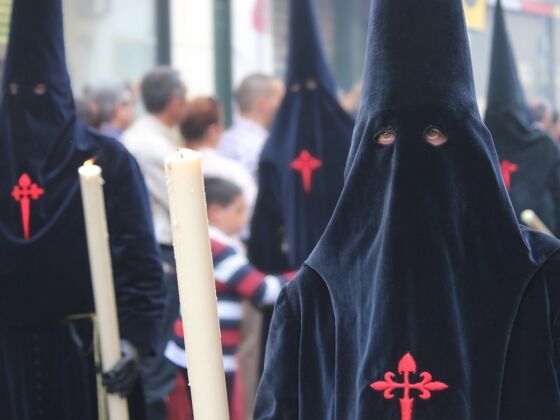WE TURNED THE CORNER AND THERE IT WAS, a Semana Santa procession in all its splendor. The parade of KKK-like hooded penitents marching slowly -some barefoot, some others walking on their knees, some carrying heavy wooden crosses. I was 10 and I was terrified. I’d swear there were even some penitents lashing their own backs with whips, but my mother says that’s just my imagination mixing things.

As a Spaniard, I was old enough to have seen plenty of processions, but coming from a non-religious family and a region, Galicia, where this kind of celebrations are not that big -maybe because of the weather – this was the first time I saw it live and not on TV. We were in Madrid -my parents, my sister, and me – where we always traveled to this time of year to visit my grandma, and we were coming back from the cinema when we saw it.
Religion has always felt foreign to me. Even though Spain is culturally catholic, it’s easy to live without realizing what that really means. The shock of finding yourself in front of some living proof of religious passion and fervor is then greater -people are willing to suffer for their faith, you realize, and not only physically. Every year somewhere in Andalusia a procession has to be canceled due to rain. The news seems to be showing the same footage year after year of people crying because the image of the virgin or saint has to be taken back to the church.
A few years ago, when I was still studying, I went with two friends to O Corpiño, one of the few villages in Galicia where they still perform exorcisms. We were preparing an in-depth multimedia piece for school about the relationship between popular beliefs -religion included -and science, and as the intrepid future reporters we were, we tried to talk to the priest with the hope of getting some footage of an actual exorcism.
We didn’t get it. He just pointed us to the bazaar shop, where I hung out taking pictures of the creepy wax body members they sold while my friends entered the church for some kind of special ritual against evil eye. They came back giggling because one of them had startled when the priest approached her with a crucifix, and he had asked her if she was scared of it. We joked hers would be the next exorcism.
A psychologist we talked to told us sometimes exorcisms work as a form of catharsis, not only for the possessed, but also for their families. Semana Santa processions seem to work similarly, and that’s what I imagine makes me uncomfortable around them. Those who attend and are not mere tourists or curious spectators seem to be setting something free inside them -through suffering and crying, yes, but also through joy and celebration. People throw flowers to the images of the saints, yell “¡guapa! ¡guapa!” to the Virgin; others just get drunk and party all night.
When I say I’m scared of these particular celebrations, I don’t mean I have a phobia that would have made all the devil radars of that priest raise their alarms. It has more to do with childhood fears, with the somewhat sinister imagery of the Catholic Church, and with knowing I will never be able to understand what those penitents and attendants are feeling. The covered faces, blood stains, and exaltation of suffering don’t help either.
Maybe one day I’ll face my fears and travel to Málaga during Semana Santa. I’ll try to stay among the crowds and throw flowers to the virgin. Or I’ll just have palpitations and escape to the beach to feel my own kind of catharsis swimming in the sea.